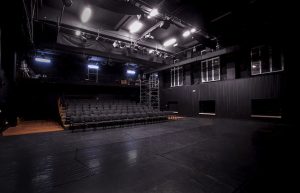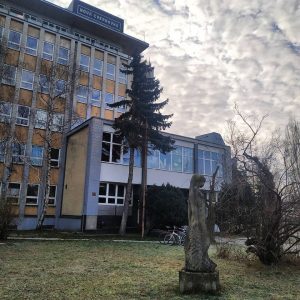Aréna Theatre is the oldest theatre building in Bratislava. It was founded in 1828 on the Petržalka bank of the Danube River. Initially, it served as a summer theatre—an open-air amphitheater—which is why it was named Aréna. In 1898, a new building was constructed on the same site, and its appearance has remained almost unchanged to this day. The theatre is closely linked to the early artistic career of the renowned theatre director Max Reinhardt, who performed there as a young actor for several seasons. After World War II, when Petržalka was annexed to Bratislava, the theatre building was closed to the public for nearly fifty years, serving instead as a storage facility. In 1994, Slovak artist Milan Sládek established the Foundation for the Restoration of the Aréna Theatre, and partial renovations began the following year. During this time, the international pantomime festival Kaukliar was regularly held at the theatre. In 2002, after Divadlo Aréna came under the administration of the Bratislava Self-Governing Region, the well-known Slovak actor Juraj Kukura was appointed as its director. He introduced a new multi-genre concept, with a strong focus on theatre—both contemporary and classic drama addressing current social themes—as well as musical and educational projects. In 2021, the first full-scale renovation of the building began. In 2024, the theatre returned to its newly reconstructed spaces.
The Central Slovak Gallery is located in the centre of Banská Bystrica. It is a regional gallery with program focused on presentation, research and creation of collections of modern and contemporary art. The gallery is an open-minded institution which, along with the professional work of the collection gallery, offers to the general public high-quality curatorial and educational projects with an expanded accompanying program, including artistic genres such as contemporary literature, dance, music, performance and film. Exhibition and educational activities are realized in three historical buildings located in the city centre. Temporary exhibitions are organized in turns in the buildings of the former city hall Praetorium and Bethlen’s House. A permanent exhibition of Dominik Skutezky’s paintings is made available in the building of his family villa with the garden.
The Academy of Arts Theatre
The Academy of Arts Theatre provides students of the Department of Acting and the Department of Theatre Directing and Dramaturgy with a space for their artistic creation and its presentation. It offers them the opportunity to create beyond the standard curriculum and to confront their artistic endeavors with an audience. This professional theatre, involving both students and teachers, is open to the public for nine months of the year, from October to June. The program consists of a permanent repertoire featuring graduation and year-end productions by students of the Department of Acting and the Department of Theatre Directing and Dramaturgy.
The theatre offers two spaces—a large and a small theatre studio. The theatre’s facilities are used to their fullest capacity. In addition to rehearsal processes, final exams for core subjects, and theatre premieres, the theatre also serves as a venue for workshops, conferences, seminars, guest performances, and, last but not least, the international project for art academies – Artorium.
Telocvičňa – Dance Residency Center is a former gym that contains the basic facilities and equipment necessary for dance and movement. It has served as a non-commercial, residential space for professional dance makers since 2016 in the preparation phase of works and for their day to day training. It is integrated into the premises of Nová Cvernovka, a prominent cultural hub (with ateliers and theatre/concert space) in Bratislava, but operates independently. Since 2018, PlaST has been coordinating its functioning, residency activities, international cooperation, research, and at the same time striving to improve its facilities as well as providing educational programmes aimed at the wider public. Despite its makeshift nature (a need to undergo larger renovation works), Telocvičňa has quickly become an important hub in Slovakia and the wider region for dozens of dance and performance artists. It strives to support established artists as well as the younger generation, and underlines the importance of intergenerational cooperation. Currently it contributes to the strengthening of the dance community, it is an important continuity protecter in the time of pandemics as well as financial crisis. A tool for strengthening the links between the different actors, but it is also a space for dance educational activities for the wider public.
In 2021, thanks to the support of the Slovak Arts Council and the support of the Cultural Fund of City of Bratislava as well as the efforts of the dance artists themselves, the adjacent space underwent a basic renovation, giving the space the facilities for an office, 2 storage rooms, a shower room, and a kitchen/brainstorming area. It is collaborating with the Bratislava self-governing region on a project aiming to bring contemporary dance to elementary and high school students and seniors in the Bratislava region. Since 2021, it has been running a Residency programme, which includes supporting progressive work by local and international teams, and is also running a regional research project with partners from Hungary, Poland and the Czech Republic, focusing on the link between art and science in the climate change issue Nature of Us.
Slovak Dance Platform Main Venue / Accreditation Centre
A4 is an independent cultural centre focusing on contemporary forms of professional theatre, dance, music, film, visual art and new media.
Established in 2004, it became one of the first cultural centres in Slovakia founded by a bottom-up initiative.
Since its beginning, A4 has been a vivid and active location on the Central European cultural scene, an open field for creative experimentation as well as a home for fresh and unique experiences.
Besides presenting innovative contemporary art, it actively supports new creative activities and education. A4 engages in public debate on important social issues, and attempts to foster conditions for non-commercial cultural activities.
The Studio 12 is a unique multimedia space designed for presentation of new drama and contemporary art. The dramaturgy focuses mostly on residential and visiting theatre activities. The space presents the art of various Slovak and international theatre companies and ensembles, with a particular focus on original and contemporary drama, and new production approaches. It also supports the making of devised theatre projects by young artists. Besides theatre projects, Studio 12 offers space for all kinds of open discussions and seminars, workshops and book presentations, festivals, projections, multi-genre events, music concerts as well as other cultural and social activities.
Nová Cvernovka is a cultural and creative center located in the former chemical school in the suburbs of Bratislava, Slovakia. Founded by the creative community in 2016, that moved in after being pushed out from a gentrifying area.
Laid out on 18 000 m2 it operates a multifunctional venue, an outdoor terrace and a podium, community garden, playground and houses co-working space, public library and 76 art and creative studios. It provides broad-spectrum of cultural and educational programs in music, visual arts, literature, film, performing arts and multi-genre activities that enrich the palette of Bratislava’s cultural scene with different formats of events.
The center aims to function not only as a free space for people from the creative industry but also as an entity that plays an active role in civic society. We are searching for innovative collaboration models between non-profit organizations and the public sector and bringing new life into abandoned places by transforming them into centers of culture and creativity.
Nová Cvernovka brings a dramatically diverse mix of functions to the boundary between two zones, a low-density residential neighborhood, and an industrial zone. It is a place for broad local use that has enliven the neighborhood.
Dance Studio Theatre (Divadlo Štúdio tanca) has been operating since 1998 in Banská Bystrica. Unique in its artistic focus, it follows the path of original creation, which respects artists in their creative expression and opinion and continuously supports the creation of original dance productions and their regular performance.
Authenticity, timeliness and a strong international artistic ensemble in the common denominator of contemporary dance, this is the Dance Studio Theatre. As part of its mission, it has premiered 55 full-length productions, including 5 performances for children and many outdoor and educational dance projects. In its 22 years on the Slovak theatre scene, it has staged more than 1400 performances, including 350 on visiting domestic and international stages, and presented its work to more than 120,000 spectators. Since 2010, it has been the only established entity in Slovakia operating on its own permanent stage.
Reflecting the current socio-political situation of 2014-2017, the Dance Studio Theatre has also become a civically active entity – as a direct opponent of opinions questioning the need for contemporary art. It remains in this position to this day, aware of the need to guard the values of democracy and humanity.
The Dance Studio Theatre productions are regularly performed on several domestic stages and Slovakia has been represented at prestigious international festivals in the Czech Republic, Poland, Hungary, Bosnia and Herzegovina, Russia, Germany, Italy, Belgium, France, Switzerland, Egypt, Japan, India, Panama and the Dominican Republic. His distinctive artistic attributes have earned him numerous awards, including the Mayor’s Award of the City of B. Bystrica and the Award of the Minister of Culture of the Slovak Republic.












